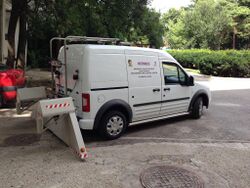Earth:Hermes Road Measurement System
The Hermes Road Measurement System is the result of the EU-funded project[1] Innovative, Highly Efficient Road Surface Measurement and Control System that was undertaken between August 2012 and July 2014. The project was funded through the European Union's Seventh Framework Capacities Programme[2] that aimed at supporting research for the benefit of small-to-medium enterprises (SMEs). This is realised by cooperation between a group of SMEs from several European countries, working in collaboration with a number of research and technological development (RTD) institutes, collectively constituting the project's consortium.
The Hermes system enables both the longitudinal and transversal profiles of a road to be simultaneously measured from a specially equipped vehicle travelling at normal road speeds. The developed approach has the advantage of eliminating the need for an inertial reference level, whilst improving accuracy of measurements by addressing errors otherwise resulting from the dynamics of a moving vehicle. An additional feature of this system is integration of the road profile measurements with their precise geographical location.
Objectives
The project's objectives include the following:
- Development of a highly accurate longitudinal and transversal road measurement methodology.
- Design and implementation of a low-cost embedded system to execute the longitudinal and transversal measurements.
- Implementation of an integrated solution for road profile measurements incorporating state-of-the-art GIS techniques for accurate localisation.
- Development of a novel information system for data logging, data extraction and data exchange with existing related systems.
- Performance of numerous field-trials, in countries represented by the project partners, of the complete system in roads having a wide range of characteristics in order to optimise system performance.
System characteristics
Measured parameters
These include transversal road profile, macro-texture measurements, longitudinal profile, rut depth, rut width, cross fall, curve radius, cracks, International Roughness Index (IRI), [citation needed] mean profile depth, vehicle speed, position relative to the start point, GNSS position, together with pavement imaging and time-stamping of measurements.
Accuracy
- GNSS position horizontal accuracy: ≤0.5m RMS at speed up to 100 km/h
- Relative position to start of measurements: ≤0.5% of travelled distance.
- Longitudinal profile vertical resolution: ≤1.5mm.
- Longitudinal profile sampling interval: ≤250mm.
- Reporting interval of longitudinal profiling: ≤500mm.
- Transversal profile vertical resolution: ≤1.5mm.
- Transversal profile sampling interval: ≤350mm.
- Transversal profile repetition interval: ≤10m.
- Reporting interval of transversal profiling: ≤20m.
- Timestamps: ≤5ms.
Standards compliance
The work has been set to meet a number of requirements that were formed based on the results of questionnaires collected from interested parties. Hence, the following standards are met:
- EN 13036-1 Macrotexture Depth.
- EN 13036-2 Friction.
- EN 13036-3 Horizontal Drainability.
- EN 13036-4 Pendulum Test.
- EN 13036-5 Longitudinal Uneveness.
- EN 13036-6 Transverse Profiles.
- EN 13036-7 Straightedge.
- EN 13036-8 Uneveness.
- EN ISO 11819-1 Statistical Pass-By.
- EN ISO 13473-1 Mean Profile Depth.
System description
The Hermes system comprises a mobile unit, i.e., a special measurement vehicle having laser projection and camera imaging equipment. Acquired data is logged by a computer using a relational database. Data is subsequently post-processed using Structured Query Language-based queries, together with sophisticated custom-developed data analysis software.
The measurement principle is based on projecting a laser line on the road surface and recording its image using a high resolution camera of high frame rate. The deviation of the laser line is measured, which corresponds to undulations of the road surface.
A novel automated pothole detection algorithm has also been developed to automatically characterise the quality of the road surface and detect potentially hazardous defects. A specially-developed GNSS controller provides high accuracy localisation of acquired measurement data.
Dissemination and exploitation
The developed system addresses the needs of a broad spectrum of potential end-users, including road maintainers, road constructors, air-field maintainers and national technical control centres responsible for road maintenance. The novel Hermes technology has been disseminated through a range of different activities including the following:
- Publication of results in academic and scientific journals such as the IEEE Communications Society Journal.[3]
- Organisation of Open Days, Workshops and Conferences such as the Baltic Electronics Conference that took place in Tallinn, Estonia.[4][5]
- Promotion of results at European and international conferences such as the IEEE International Conference on Communications (ICC 2014)[6] and HiPEAC 2014, Workshop on Reconfigurable Computing (WRC).[7]
- Promotion at exhibitions and trade shows such as the Bucharest International Technical Fair TIB 2013[8] and Siftex Exhibition, St. Petersburg, Russia.[9]
Consortium
SME participants
Research and technological development partners
- National Institute of R&D for Optoelectronics[14]
- Tallinn University of Technology, Thomas Johann Seebeck Department of Electronics[15]
- Electronics Design[16]
- Telecommunication Systems Institute.[17]
References
- ↑ "FP7 - Hermes". hermesroadmeasurement.eu. http://www.hermesroadmeasurement.eu/index.html.
- ↑ "European Commission: CORDIS: FP7:Research for the benefit of SMEs". europa.eu. http://cordis.europa.eu/fp7/capacities/research-sme_en.html.
- ↑ "IEEE Communications Society". comsoc.org. http://www.comsoc.org/.
- ↑ "The Baltic Electronics Conference Home Page". ttu.ee. http://www.elin.ttu.ee/bec/14/.
- ↑ Mõlder, A.; Märtens, O.; Saar, T.; and Land R. Extraction of the variable width laser line. In: Proceedings of the 14th Biennial Baltic Electronics Conference: 2014 14th Biennial Baltic Electronics Conference, Tallinn, Estonia, 6–8 October 2014. IEEE, 2014, 2014. pp. 157–160
- ↑ Karkazis, P.; Papaefstathiou, I. ; Sarakis, L. ; Zahariadis, T. ; Velivassaki, T.-H. ; Bargiotas, D. Evaluation of RPL with a transmission count-efficient and trust-aware routing metric. In Communications (ICC), 2014 IEEE International Conference on, Sydney, NSW, 10–14 June 2014, pp. 550-556
- ↑ Dollas A. FPGA Supercomputers as Compute Servers: Are We There Yet?, In 8th HiPEAC Workshop on Reconfigurable Computing, Vienna-Austria, 20–22 January 2014
- ↑ "TIB Bucharest". tradefairdates.com. http://www.tradefairdates.com/TIB-M3360/Bucuresti.html.
- ↑ "Sfitex". primexpo.ru. http://sfitex.primexpo.ru/media/23/sfitex_13_psr_eng.pdf.
- ↑ "Eesti Koduleht". ardoran.ee. http://www.ardoran.ee/.
- ↑ "Wing Computer Group: Prin noi succesul tau este garantat!". wing.ro. http://www.wing.ro/.
- ↑ "Home". mobilemedia.gr. http://www.mobilemedia.gr/.
- ↑ "Prometeo Innovations". prometeoinnovations.com. http://prometeoinnovations.com/.
- ↑ "INOE 2000 - Home". http://www.inoe.ro/en/.
- ↑ E-turundusagentuur ADM Interactive. "Avalehekülg < Tallinna Tehnikaülikool: Sinu elustiil!". ttu.ee. http://www.ttu.ee/.
- ↑ "Electronics Design, Ltd.". electronics.ee. http://electronics.ee/eng/index.html.
- ↑ "Telecommunication Systems Research Institute-Ινστιτούτο Τηλεπικοινωνιακών Συστημάτων". tsi.gr. http://www2.tsi.gr/?lang=en.
 |



